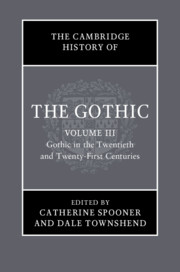Book contents
- The Cambridge History of the Gothic
- The Cambridge History of the Gothic
- The Cambridge History of the Gothic
- Copyright page
- Contents
- Figures
- Notes on Contributors
- Acknowledgements
- Introduction: A History of Gothic Studies in the Twentieth and Twenty-First Centuries
- 3.1 Gothic and Silent Cinema
- 3.2 Gothic, the Great War and the Rise of Modernism, 1910‒1936
- 3.3 Gothic and the American South, 1919‒1962
- 3.4 Hollywood Gothic, 1930–1960
- 3.5 Gothic and War, 1930‒1991
- 3.6 Gothic and the Postcolonial Moment
- 3.7 Gothic and the Heritage Movement in the Twentieth and Twenty-First Centuries
- 3.8 Gothic Enchantment: The Magical Strain in Twentieth and Twenty-First-Century Anglo-American Gothic
- 3.9 Psychoanalysis and the American Popular Gothic, 1954–1980
- 3.10 Gothic and the Counterculture, 1958‒Present
- 3.11 Gothic Television
- 3.12 Gothic and the Rise of Feminism
- 3.13 Gothic, AIDS and Sexuality, 1981–Present
- 3.14 The Gothic in the Age of Neo-Liberalism, 1990‒Present
- 3.15 The Gothic and Remix Culture
- 3.16 Postdigital Gothic
- 3.17 Gothic Multiculturalism
- 3.18 Gothic, Neo-Imperialism and the War on Terror
- 3.19 Global Gothic 1: Islamic Gothic
- 3.20 Global Gothic 2: East Asian Gothic
- 3.21 Global Gothic 3: Gothic in Modern Scandinavia
- 3.22 Gothic in an Age of Environmental Crisis
- 3.23 Gothic and the Apocalyptic Imagination
- Select Bibliography and Filmography
- Index
3.15 - The Gothic and Remix Culture
Published online by Cambridge University Press: 29 July 2021
- The Cambridge History of the Gothic
- The Cambridge History of the Gothic
- The Cambridge History of the Gothic
- Copyright page
- Contents
- Figures
- Notes on Contributors
- Acknowledgements
- Introduction: A History of Gothic Studies in the Twentieth and Twenty-First Centuries
- 3.1 Gothic and Silent Cinema
- 3.2 Gothic, the Great War and the Rise of Modernism, 1910‒1936
- 3.3 Gothic and the American South, 1919‒1962
- 3.4 Hollywood Gothic, 1930–1960
- 3.5 Gothic and War, 1930‒1991
- 3.6 Gothic and the Postcolonial Moment
- 3.7 Gothic and the Heritage Movement in the Twentieth and Twenty-First Centuries
- 3.8 Gothic Enchantment: The Magical Strain in Twentieth and Twenty-First-Century Anglo-American Gothic
- 3.9 Psychoanalysis and the American Popular Gothic, 1954–1980
- 3.10 Gothic and the Counterculture, 1958‒Present
- 3.11 Gothic Television
- 3.12 Gothic and the Rise of Feminism
- 3.13 Gothic, AIDS and Sexuality, 1981–Present
- 3.14 The Gothic in the Age of Neo-Liberalism, 1990‒Present
- 3.15 The Gothic and Remix Culture
- 3.16 Postdigital Gothic
- 3.17 Gothic Multiculturalism
- 3.18 Gothic, Neo-Imperialism and the War on Terror
- 3.19 Global Gothic 1: Islamic Gothic
- 3.20 Global Gothic 2: East Asian Gothic
- 3.21 Global Gothic 3: Gothic in Modern Scandinavia
- 3.22 Gothic in an Age of Environmental Crisis
- 3.23 Gothic and the Apocalyptic Imagination
- Select Bibliography and Filmography
- Index
Summary
Gothic media have reached unprecedented levels of commercialisation and, as a result, have begun to proliferate in new and interesting ways. From its roots in twelfth-century architecture and eighteenth-century fiction and theatre, Gothic has always been multimedia, and has always been remixed. Around the turn of the twenty-first century, however, the genre’s patchwork qualities began to take on a new intensity. What are the implications of this rapid rise in remixed Gothic, both for remix practices and for the Gothic mode? This chapter explores how remixes such as the GIF, the digitised photograph, the updating database and the social media network have all functioned in ‘monstrous’ or Gothic ways.
- Type
- Chapter
- Information
- The Cambridge History of the GothicVolume 3: Gothic in the Twentieth and Twenty-First Centuries, pp. 302 - 322Publisher: Cambridge University PressPrint publication year: 2021
- 3
- Cited by

